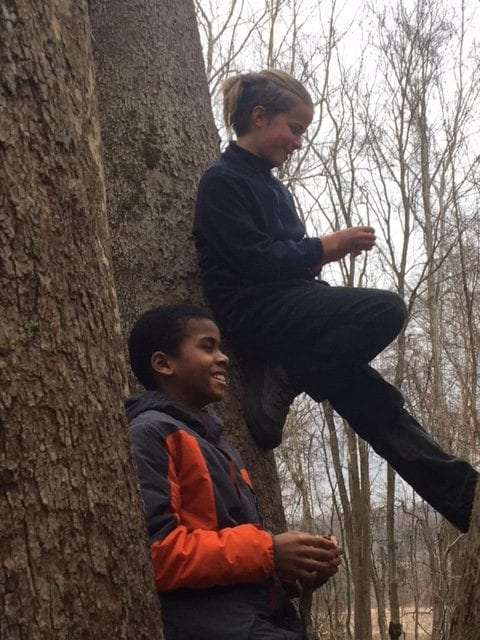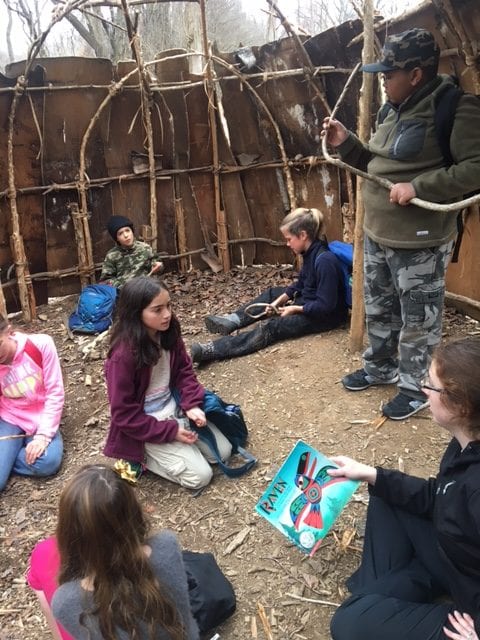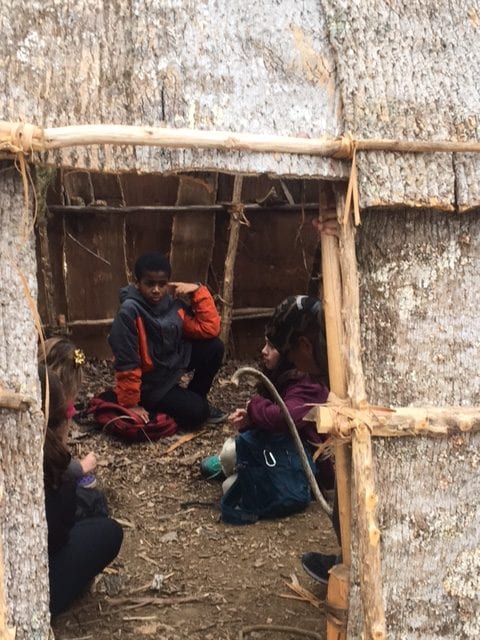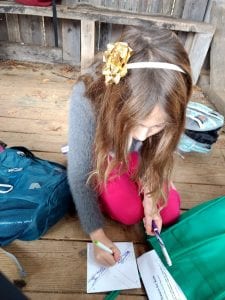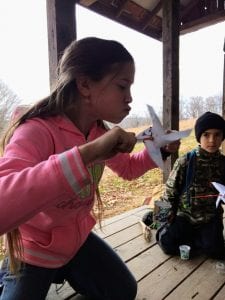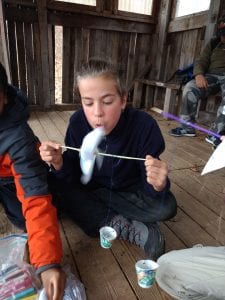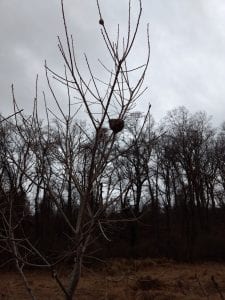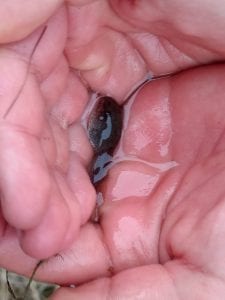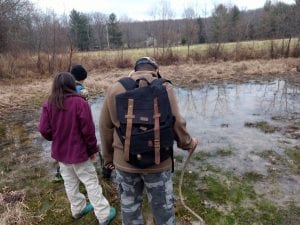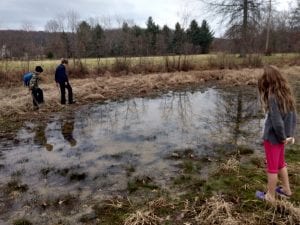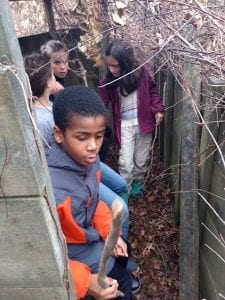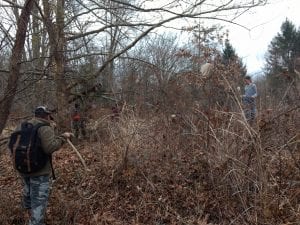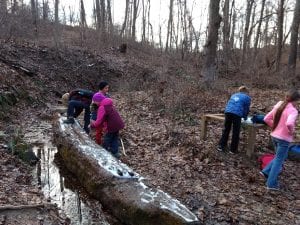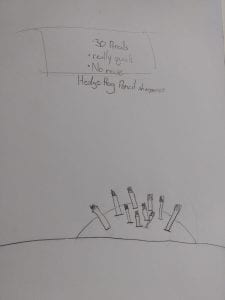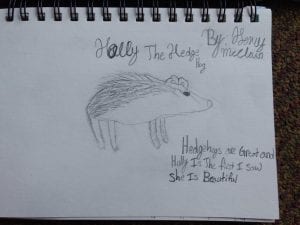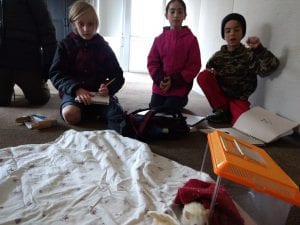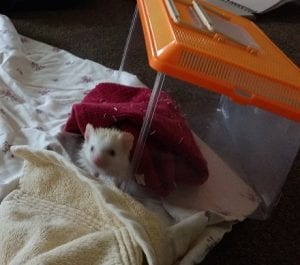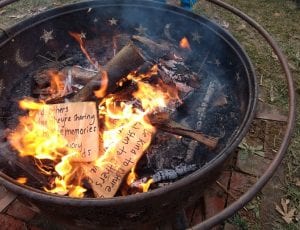Week 12: 12/5/2017
This semester has been about discovering inventions, technologies and other innovations that have been inspired by nature, whether that be plants, animals or even weather and other natural phenomenon. Today we got to make our own windmills because we were talking about how wind turbines have been redesigned to be more efficient based off of humpback whale fins. Wind turbines are a source of renewable energy so making them better at their job is a useful way of getting more energy out of them. A humpback whale’s fins are bumpy on the leading edge, which reduces resistance as they swim through the water. By adding similar bumps to the edges of wind turbine blades, as the blade spins it encounters less resistance, which keeps it spinning easier and for longer.
We hiked to the gazebo for our usual snack and introduction to the day. After, we hiked down to the Ed Hut for our experiment. To make the windmills you need a windmill template, which I just created from the video link below. The template is a square piece of cardstock with drawn lines on it so kids know where to cut and fold. You also need a straw, a wood dowel or skewer that fits easily inside the straw, tape, a hole punch, scissors, string, a paper cup, marbles or other objects for weights, and coloring utensils if you want to decorate your windmill.
https://eco-friendly.wonderhowto.com/how-to/build-your-own-windmill-with-household-materials-321506/
We spent some time adding designs to our windmills before cutting and folding them and assembling them. The final touch was adding a mini bucket to our windmill so we could use the force of wind we create with our breath to try to raise the bucket with weight in it. Some of us put a few beads into the bucket and the bucket went up really quickly so instead of adding a few more they added a lot! Eva even got her bucket half way up with 13 beads! 13 was almost too many though because no one could get the bucket up the entire way. James was able to raise his bucket all the way with 11. Others tried a small amount and then enjoyed the windmills. After we finished experimenting with our windmills, we packed up and headed to the climbing tree and Native American Longhouse. Everyone wanted to spend some time in the climbing tree since it was the last time they would get to hike this direction in Fall. At the Longhouse we all gathered around and imagined ourselves back when the Lenape lived off the land here in Maryland. We imagined that this was the size of our home, that we shared this space with family and that we were going to listen to a Native American legend. Legends and stories were told from memory by the Lenape, they didn’t use books like we use today, but we were going to read from a book and the book is called “Raven: A Tricksters Tale.” This story is based off of Native American legends from the Pacific Northwest tribes. It tells the story of how the bird Raven stole the sun and gave it to the people.
- The Climbing Tree
- Reading Raven in the Longhouse
- The Longhouse
After listening to the story and finishing snack from earlier, we headed to a new place we haven’t explored this semester, the Sunflower Meadow. At the back of the meadow is a very large vernal wetland. In the late Spring and Summer it is full of water to your knees with a small island in the center. This time of the year the water is almost gone and you can walk straight to the island and your shoes never get wet. The ground does feel different under your feet, it’s not as hard and it has more mounds and dips. The plants growing here are different too because half of the year they’re underwater. On the island we found a really cool wildlife blind that has been taken over by vines and brambles. The kids found a way in and we discovered that even though it looks really small you can actually stand straight up in it! They also found a mouse stash in the corner ordained with a leaf and fresh berries.
We also spent some time exploring the wet part of the vernal pools and we found two different spots with standing water. Getting closer, Lev and James saw that there were a ton of tadpoles! The water was only a few inches deep so it’s amazing these tadpoles have survived this long especially when they most likely hatched in summer. We got our feet wet and gently picked up a couple of tadpoles. They are most likely green frog tadpoles based on their sheer size. They could be bullfrog tadpoles too but those were likely to be even bigger. As we walked around Noa observed that the ground was much easier to walk on in certain places because of the mats of small plants. They definitely helped from letting your feet get sucked into the wetland soil. Solace lost a shoe (it was recovered!) so that wetland soil is definitely still wet enough to steal a shoe.
It was time to head back and on our way we found some really cool bird’s nests. That is one of the many great things about this time of the year, you can see all the things that the leaves hide, like bird and squirrel nests, holes in trees and other cool features. We also saw some birds close up as we passed the long gone sunflower field, mourning doves. They perched in a branch and let us get rather close before fluttering away. What a great day to explore! I’m so glad we got the chance since next week is our final class of the semester. Take a look at some of our pictures below.
Week 13: 12/12/2017
Today is our final day of Biomimicry Homeschool for Fall! It was a chilly day so how perfect that we were finishing the day with a huge campfire where we were gathering with the other homeschoolers and their families and ours too. We started the day by sharing stories of the snow that had fallen over the weekend. We also got to meet one of Irvine’s Animal Ambassadors, hoping she would give us some inspiration for a new invention! Holly the Hedgehog made an appearance. With our journals ready, we watched her walk around, munch on some of her dry food and burrow under her towels. Some people sketched the hedgehog while others started coming up with invention ideas. Noa invented a pencil sharpener that can sharpen multiple pencils at once and because hedgehogs are nocturnal she wanted it to be a quiet pencil sharper. Fantastic idea! Lev drew a prickly body suit that allows the quill like spikes to go flat or poke out, just like a hedgehog, awesome! Henry drew the hedgehog and wrote a haiku about her that you can read in the pictures below.
We also talked a little about a hedgehog’s adaptations. Since they are nocturnal, they need to have a great sense of smell to sniff out their prey, like insects. They also need to have good hearing, which is why her ears are so large compared to her body size. She also has an okay sense of night eyesight too, so she can find her way around, which is why we had the lights off in the room since I had to wake her up from her nap so she could visit us. We also reviewed what type of animal she is, a mammal and the three things that make a mammal difference from other animals: they have hair, they produce milk and they have a third ear bone. And then there are the quills. Hedgehogs don’t release their quills like a porcupine can (those don’t shoot out either, which was a question someone had). If she pokes someone or something her quills stay in her body. Holly wasn’t poking anyone since she was happy to curl up in her towel and walk around and explore. After meeting her, we headed outside with the hopes of finding some leftover snow and possibly animal tracks but most of the snow had melted by the afternoon. We hiked to the stream, a spot we haven’t visited since we made the beaver dam. Everyone found what little snow remained and we played for a short time before fingers got cold and it was time to warm up by the campfire.
At the campfire we enjoyed s’mores and other treats and played with all of our friends in the amphitheater. The air was getting cold quickly so we were all grateful for the warmth of the fire. Thank you so much everyone for such a fantastic semester, it was made so much better by everyone loving the class and being outside in nature. Some of the highlights of the semester and our favorite things were visiting the climbing tree, playing predator/prey in the meadow, climbing more trees, building our own campfires, doing some really cool experiments, exploring different wetlands and catching frogs and tadpoles, and of course spending time with each other here at Irvine!

